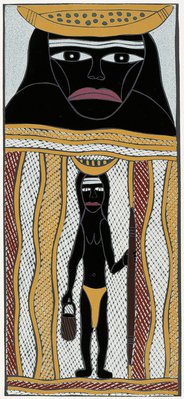Title
Nyapililŋu Wapitja
1996
Artist
-
Details
- Alternative title
- Nyapililngu Wapitja
- Place where the work was made
-
Yirrkala
→
North-east Arnhem Land
→
Northern Territory
→
Australia
- Date
- 1996
- Media category
- Materials used
- triptych: colour linoprint (reduction method)
- Edition
- 13/50
- Dimensions
-
176.0 x 45.0 x 4.5 cm frame
:
a - side panel, 46 x 20.8 cm, Image
a - side panel, 59 x 40 cm, Sheet
b - centre panel, 46 x 20.8 cm, Image
b - centre panel, 49 x 40 cm, Sheet
c - side panel, 46 x 20.8 cm, Image
c - side panel, 59 x 40 cm, Sheet
- Signature & date
Signed l.r. [part 3], pencil "Naminapu Maymuru". Not dated. Part 1 and the centre panel are neither signed nor dated.
- Credit
- Purchased 1996
- Location
- Not on display
- Accession number
- 280.1996.a-c
- Copyright
- © Naminapu Maymuru-White
- Artist information
-
Naminapu Maymuru-White
Works in the collection
- Share
-
-
About
This print is a triptych and was first produced in a black and white format in 1989. The reduction method of printing used for this colour version means that the original 1989 blocks have been destroyed in the colour printing process. The layers of coloured ink on the surface of the paper have been built up to resemble the complex layers of paint on a bark painting; hence giving the print an extremely strong appearance.
Part a - Nyapiliŋu, the subject of this print, is the most important female ancestor of the Maŋgalili clan. The Wapitja is the sacred digging stick carried by Nyapiliŋu and forms the inner shape of this print.
Part b - The cross represents the string that Nyapililŋu spun out of possum fur and wore; it also symbolises how important she was. The horizontal lines are her 'raki', they represent a line of string.
Part c - The animals represent an important role within the clan, for food, furs and string. The 'raki' is a symbol of their journey of the person who dies and how the spirit will travel.
Australian Art Department, AGNSW, 1996
-
Places
Where the work was made
Yirrkala
-
Exhibition history
Shown in 3 exhibitions
Another Country, Art Gallery of New South Wales, Sydney, 04 Jul 1999–02 Apr 2000
Title Deeds: Aboriginal and Torres Strait Islander Works from the Collection, Art Gallery of New South Wales, Sydney, 05 Jul 2000–05 Nov 2000
ochre: bark paintings from the Collection (2000-01), Art Gallery of New South Wales, Sydney, 02 Nov 2000–06 May 2001
-
Bibliography
Referenced in 1 publication
-
Djon Mundine, Art and Australia (Vol. 34, No. 3), `Finding the Body The National Aboriginal and Torres Strait Islander Art Award', pg. 319-321, Sydney, Jan 1997-Mar 1997, 319-321, 320 (colour illus.).
-



